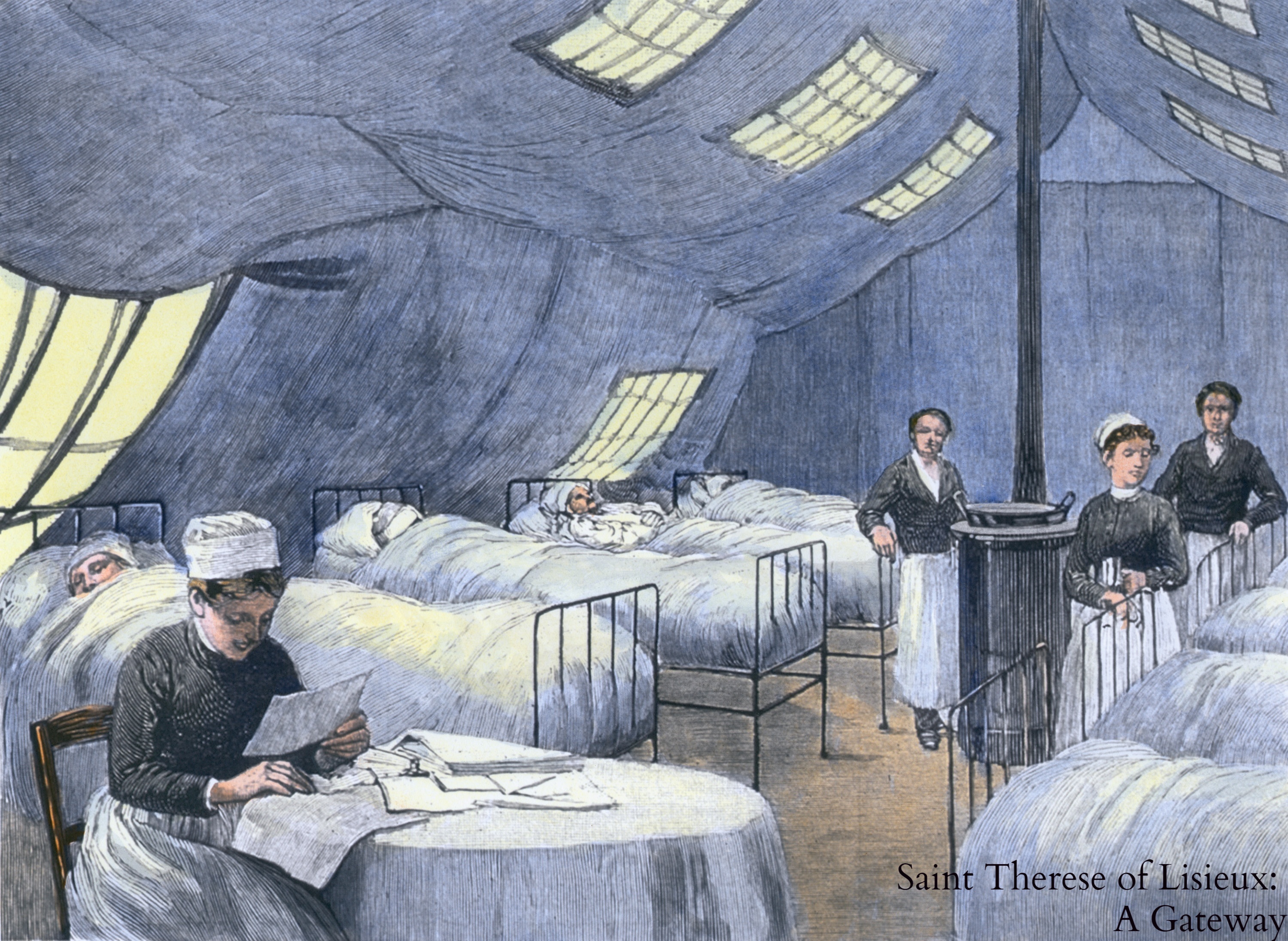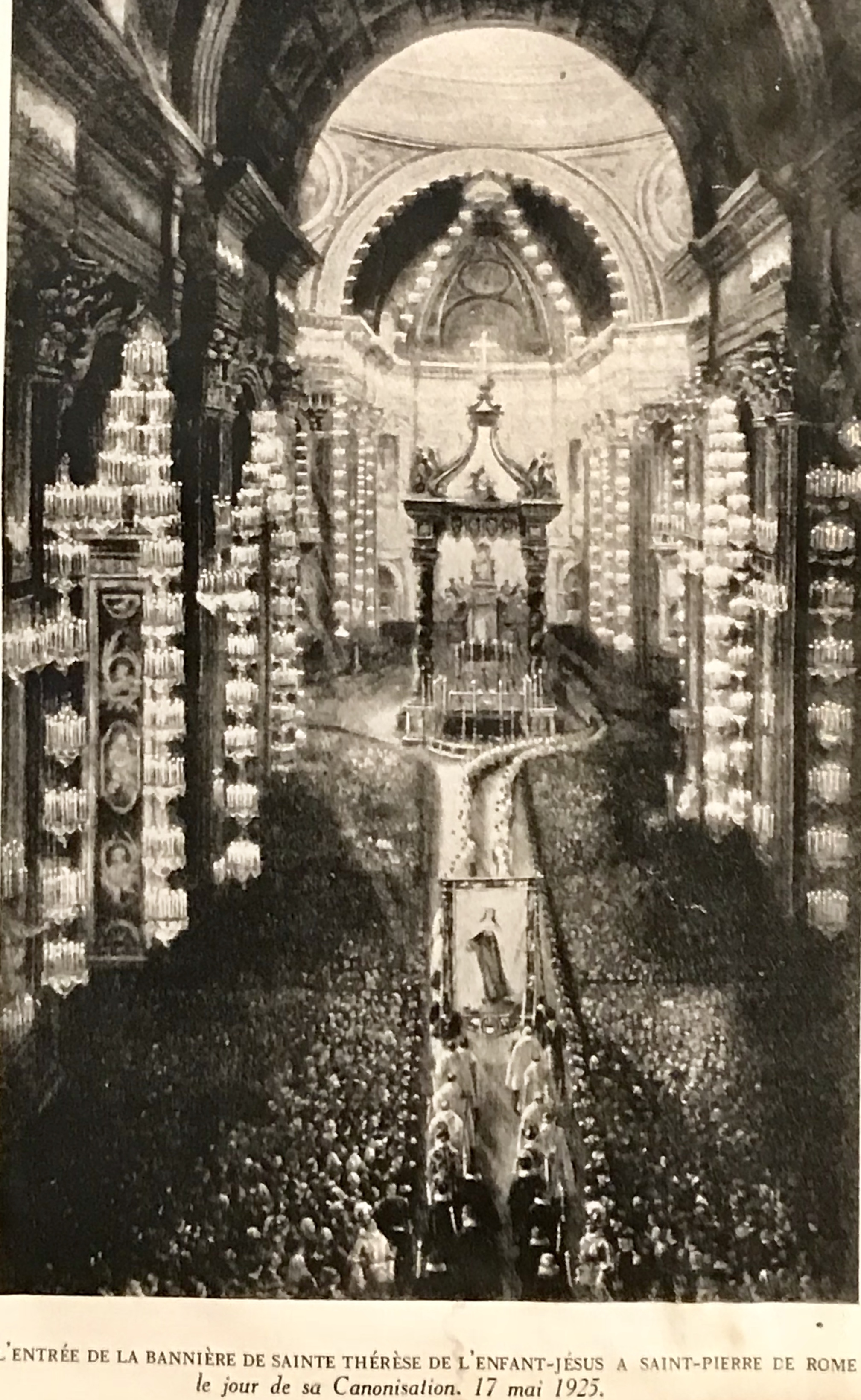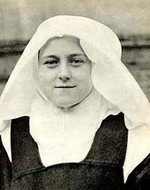Saint Therese of the Child Jesus
of the Holy Face
Entries by Maureen O'Riordan (555)
St. Therese and the influenza pandemic in the Lisieux Carmel, 1891-1892

Asian Flu epidemic of 1889-90 In Paris patients are treated in a supplemental tent hospital A nurse attends to several patients during the winter of 1889-90.
St. Therese of Lisieux and the Influenza Pandemic of 1891-1892
Part 2: Context
Saint Therese of Lisieux also lived through a sudden and deadly pandemic in 1891-1892. In 2020, what can we learn from how she responded?
The external facts are simple: a pandemic of influenza swept the world, reaching the Carmelite monastery in Lisieux just after Christmas in 1891. Only the three youngest of the 25 nuns (including Therese, then 18) escaped infection. In six days, the three oldest nuns in the community died of it. During the epidemic, Therese took on many new responsibilities. In her memoir she wrote briefly but eloquently about this experience.
The “Asiatic flu” pandemic
The pandemic that affected the Lisieux Carmel was a recurrence of the deadly “Asiatic flu” or “Russian flu” pandemic first reported in Russia in 1889. The last great pandemic of the 19th century, it killed more than a million patients around the world. The pandemic was heavily covered in the newspapers, which sound eerily reminiscent of today: hospitals so overcrowded that they pitch tents in public parks; the funeral homes unable to cope with the many dead.
Although airplane travel was not in question, the epidemic circled the globe in four months. This influenza peaked in St. Petersburg on December 1, 1889 and in the United States during the week of January 12, 1890. The first outbreak ravaged France at the end of 1889 and the beginning of 1890. It recurred several times from 1891-1895: the outbreak at Lisieux was part of the second recurrence.[i] Influenza invaded the Carmel right after Christmas in 1891.
The context of Therese’s life at that time
The time leading up to the pandemic contained only a few important events for Therese. (See my page “The Hidden Years”). Since February 12, 1889 her father Louis had been interned in a mental asylum, the Bon Saveur, in Caen. Her sisters Leonie and Celine had joined the household of their maternal uncle and aunt, Isidore and Celine Guerin, in Lisieux. Every week they visited their three sisters in Carmel and their father at the Bon Sauveur. Although Therese did not know it yet, Louis would return to Lisieux permanently in May 1892.
Professed on September 8, 1890, Therese was still living in the novitiate for the three years of continuing formation then customary for the recently vowed. Her sisters Marie and Pauline were her seniors in Carmel. Mother Marie de Gonzague was prioress, as she had been since Therese’s entry. About February 10, 1891,[ii] Therese was named assistant to Sister Stanislaus of the Sacred Hearts [of Jesus and Mary][iii], the sacristan, who, because Therese was slow in finishing her tasks, affectionately nicknamed her “Little Sister Amen.” During the epidemic Therese was second sacristan.
In these same months the life of the community had been relatively quiet. During the rainy summer of 1891, Mother Genevieve of St. Teresa, revered as the founder of the Lisieux Carmel, celebrated her diamond jubilee (the 60th anniversary of her profession) on July 22.[iv] The next day Celine refused her persistent suitor, Henry Maudelonde.[v] On September 11, Isidore and Celine Guerin celebrated their silver wedding anniversary.[vi] In October (probably from October 7 through October 15), Fr. Alexis Prou, a Franciscan priest, preached the community’s annual retreat. Therese’s encounter with him in the confessional was liberating for her [Web site of the Lisieux Carmel Archives]; later, she would write “He launched me full sail upon the waves of confidence and love . . . .” That same week, on October 10, Fr. Maurice-Joseph Reverony, Bishop Hugonin’s vicar-general, who had introduced Therese and her father to the bishop at Bayeux on October 31, 1887 and had presented the Martins to Pope Leo XIII on November 20, 1887, died at Caen.[vii] In the end, he had been instrumental in opening the doors of Carmel to Therese. On November 24, 1891, the community celebrated the tricentenary of the death of St. John of the Cross.[viii] That anniversary was marked by a resurgence of interest in John in France, and Therese later wrote: “At the ages of seventeen and eighteen, I read no one else.”[ix] Fr. Deodat de Basly, a Franciscan, preached a triduum, and Bishop Hugonin entered the cloister and showered Therese with caresses.
Mother Genevieve of St. Teresa dies
On December 5, 1891, Mother Genevieve died. It was the first time Therese had seen someone die. She wrote:
“It was the first time I had assisted at a death and really the spectacle was ravishing . . . at the moment itself of our saintly Mother Genevieve’s birth in heaven . . . . in the twinkling of an eye I experienced an inexpressible joy and fervor; it was as though Mother Genevieve had imparted to me a little of the happiness she was enjoying, for I was convinced she went straight to heaven.”[x]
Mother Genevieve was truly venerated as a saint; even Dr. de Corniere, when he extracted a tooth from her mouth, kept it as a relic.[xi] As was usual in Carmel, when Mother Genevieve entered into her agony the community gathered at her bedside to help her with their prayers; Therese was placed at the foot of Mother Genevieve’s bed, where she remained for two hours, until the founder died. Witnessing this death might well have prepared Therese for the experience of the deaths of three lesser known sisters, under very different circumstances, only a few weeks later. These nuns died not in the infirmary, but in their cells; almost all the sisters were sick, and “as soon as a Sister breathed her last, we were obliged to leave her alone.”[xii] We shall return to Therese’s experience of death during the epidemic. .
In a growing trend toward secularism in France, the civil authorities had begun to refuse to allow religious communities to bury their deceased members on their own grounds. Fearing that the body of the founder would not be left with them, the nuns decided to preserve her heart in formaldehyde so that they would have one major relic at least near which to pray. In the end, after a delay of several weeks, the town council consented to a burial "in house," and Mother Genevieve’s body was entombed in the sanctuary of the Carmel chapel on December 23.[xiii]
The pandemic ravages the Carmel
Five days later, influenza came to the Carmel. According to the Chronicle of the Foundation, on December 28, the feast of the Holy Innocents, several nuns had to take to their beds.[xiv] By December 31, 12 of the 25 nuns were sick.[xv] Dr. de Corniere, who would later treat Therese in her last sickness, was overwhelmed with work, but he came twice a day to care for the Carmelites.[xvi] On the evening of December 31, Sister Febronie of the Holy Childhood, subprioress, showed her first symptoms as she returned from escorting Dr. de Corniere to the enclosure door.[xvii] On January 2, 1892, Therese’s 19th birthday, Sister St. Joseph of Jesus, the oldest nun in the house and the first postulant of the Lisieux community, died.[xviii]
For the rest of the story, stay tuned.
For Part 1 of this series, a timeline of the influenza pandemic at Lisieux Carmel, click the blue button:
Notes:
[i] Wikipedia, “1889-1890 flu pandemic.” https://en.wikipedia.org/wiki/1889%E2%80%931890_flu_pandemic, accessed 5/19/2020.
[ii] Story of a Soul, 3rd edition, tr. John Clarke, O.C.D. (Washington, D.C.: Washington Province of Discalced Carmelites, Inc., 1996, p. 283).
[iii] For more about Sister Saint Stanislas, including her brief statement in 1906 about her observations of Therese’s virtue, see http://www.archives-carmel-lisieux.fr/english/carmel/index.php/les-soeurs-dexperience/stanislas-des-sts-coeurs/circulaire-de-stanislas
[iv] Letters of St. Therese of Lisieux, Volume II, 1890-1897. Tr. John Clarke, O.C.D. (Washington, D.C.: Washington Province of Discalced Carmelites, 1988, p. 733, note 1).
[v] Letters, Volume II, p. 733, note 2.
[vi] Letters, Volume II, p. 735
[vii] Letters, Volume II, p. 1316
[viii] Letters, Volume II, p. 737.
[ix] Story of a Soul, p. 179.
[x] Story of a Soul, p. 170.
[xi] Sainte Therese de Lisieux (1873-1897), by Guy Gaucher, O.C.D. (Paris: Editions du Cerf, 2011, p. 349).
[xii] Story of a Soul, p. 171.
[xiii] Sainte Therese de Lisieux (1873-1897), Gaucher, p. 349.
[xiv] Cited in Letters, Volume II, p. 747, note 1.
[xv] "Biography of Sister Febronie of the Holy Childhood," http://www.archives-carmel-lisieux.fr/english/carmel/index.php/les-bonnes-vieilles/f%C3%A9bronie/biographie, paragraph 7 of the section “With Therese,” accessed 5/19/2020.
[xvi] Gaucher, p. 351.
[xvii] Circular of Sister Febronie of the Holy Childhood, Web site of the Archives of the Carmel of Lisieux, http://www.archives-carmel-lisieux.fr/english/carmel/index.php/les-bonnes-vieilles/f%C3%A9bronie/circulaire-de-f%C3%A9bronie, accessed 5/19/2020.
[xviii] "Biography of Sister Febronie of the Holy Childhood," Web site of the Archives of the Carmel of Lisieux, http://www.archives-carmel-lisieux.fr/english/carmel/index.php/les-bonnes-vieilles/f%C3%A9bronie/biographie, accessed 5/19/2020.
St. Therese canonized in Rome, May 17, 1925
 The banner of St. Therese is carried into St. Peter's Basilica in Rome at her canonization ceremony, May 17, 1925. Credit: Wikipedia, Exorcisio Te, https://commons.wikimedia.org/wiki/Category:CC-BY-SA-4.0
The banner of St. Therese is carried into St. Peter's Basilica in Rome at her canonization ceremony, May 17, 1925. Credit: Wikipedia, Exorcisio Te, https://commons.wikimedia.org/wiki/Category:CC-BY-SA-4.0
St. Therese’s Canonization Ceremony
St. Therese of the Child Jesus was canonized in Rome on May 17, 1925, 95 years ago today. The New York Times reported that at least 25,000 French and fully 15,000 American pilgrims were present for the six-hour ceremony. The basilica held almost 60,000 pilgrims, and 200,000 more waited in the square outside. For the first time, loudspeakers were installed in the Basilica, so that all the pilgrims crowded inside (many of whom could not see the sanctuary) were able to hear the Pope’s every word. This innovation was a big success.
Outer Facade of Basilica Illumined for the First Time Since 1870
Countless electric lights had been installed in the basilica for the ceremony. The newspapers reported extensively that that night, for the first time since 1870, the outer façade of St. Peter’s was illumined.
The illumination was done entirely with thousands of torches and lanterns, which, flickering in the breeze, gave the impression that the whole basilica was enveloped in a curtain of fire. It is estimated that this beautiful scene was witnessed by about a million people.
The New York Times, May 18, 1925, p. 2.
The illumination was considered a step toward the reconciliation of the church and the Italian state, for it was the first time the facade pf the Basilica had been lit up since the Pope became a voluntary “prisoner in the Vatican” after the Italian government declared war on the Papal States in 1870.
Recreate St. Therese's Canonization Ceremony for Yourself
Although the rest of this aritcle may look like a mere list of links, it is in fact, the key to a powerful interactive experience of the canonization. To respect the intellectual property of others, I can't reproduce everything on this page, but, merely by clicking the links, you can access a vivid sense of what the pilgrims experienced in 1925.
A Contemporary Eyewitness Account of St. Therese's Canonization
For a contemporary eyewitness account from Australia, which gives the reader the sense of being present, please read "Over 60,000 at St. Therese's Canonization. His Holiness Proclaims New Glory of Carmel. All Nations Represented at the Happy and Impressive Event" from the Freeman's Journal (Sydney, New South Wales, July 2, 1925).
Photographs of St. Therese's Canonization
See photographs of the celebrations at Lisieux and at Rome on the Web site of the Archives of the Carmel of Lisieux.
The Bull of Canonization for St. Therese
- To recreate the ceremony, read the Bull of Canonization. (Thanks to the Catholic Forum and the Internet Archive).
- Also see a beautiful illuminated parchment of the Bull of Canonization. It escaped the flames when Lisieux was bombed in 1944, but the parchment is twisted from the effects of the intense heat. (Thanks to the Web site of the Archves of the Carmel of Lisieux).
The Homily of Pope Pius XI at St. Therese's Canonization
See the text of the homily of Pope Pius XI. (Thanks to the Catholic Forum and the Internet Archive). That afternoon Pope Pius, who remained extraordinarily devoted to St.Therese until his death, told Dennis Cardinal Dougherty of Philadelphia that it was the happiest day of his life. After the tiring six-hour canonization ceremony, he returned to the Basilica later in the afternoon to venerate St. Therese. There many of the 200,000 pilgrims who could not gain admittance in the morning had the joy of praying with him.
A Detailed Account of St. Therese's Canonization Day by John Beevers
For a full account of the whole occasion, see this excerpt from John Beevers' book Storm of Glory: The Story of St.Therese of Lisieux. (Thanks to Hathitrust for digitizing the book). John Beevers was a British laywan who had a great love for St. Therese, translated her autobiography, and wrote two other books about her. I am greatly in his debt, for I believe that it's he who introduced me and many others to St. Therese.
On April 25, 1897, St. Therese wrote, contrasting her mission with that of St. Joan of Arc:
I understood my missionwas not to have a mortal King crowned but to make the King of heaven loved, to submit to Him the Kingdom of hearts.1
On this anniversary of St. Therese's canonization, when the whole world has such need of her way of confidence and love, let's canonize her afresh in our hearts. Above all, let's surrender our hearts to her Beloved so that we, too, can fulfill her only desire: "to love Jesus and to make Him loved."
Notes:
1. Letters of St. Therese of Lisieux, Volume II, 1890-1897. Tr. John Clarke, O.C.D. (Washington, D.C., Washington Province of Discalced Carmelites, Inc., p. 1085).
The 100th anniversary of the canonization of Joan of Arc on May 16, 1920
Icon of Joan of Arc by Brother Robert Lentz.
Available at Trinity Icon Stores
The canonization ceremony of St. Joan of Arc
Joan of Arc was Declared to have practiced heroic virtue, and thus given the title "Venerable," in 1894, in the lifetime of St. Therese, who called her "my dear sister." She was declared blessed in 1909. Her canonization took place at St. Peter's Basilica in Rome on May 16, 1920, fiveyears and one day before Therese's. Pope Benedict XV, who in 1921 would declare that St. Therese had practiced heroic virtue, presided at the ceremony. Estimates of the number of pilgrims in Rome range from 25,000 to 60,000. Newspapers report that many pilgrims had to sleep in the basilica and that many women fainted from the crush during the ceremony. (It is said, however, that the celebration for Therese far outshone that for Joan).
Photographs
Click on photographs of the canonization ceremony at the New Liturgical Movement Web site to see good photos.
Newspaper articles
- A good eyewitness account is at An Australian and St. Joan of Arc: Father Brauer of Manly College Describes the Canonization Ceremonies. (1920, September 30). Freeman's Journal (Sydney, NSW : 1850 - 1932), p. 7. Retrieved May 17, 2020, from http://nla.gov.au/nla.news-article115600407.
- On May 17, 1920, The Times of London offered a British analysis of the canonization and of Joan's sainthood in "St. Joan of Arc"
- If you read French, La Croix offers "Fete incomparable: La Canonization de Jeanne d'Arc," a marvelously detailed account on May 18, 1920.
Contemporary reflection on St. Joan and St. Therese
"St. Therese of Lisieux and St. Joan of Arc," by Maureen O'Riordan. I furnish some background on Therese's relationship with Joan, guide you to her texts about Joan, and present a few themes to empower your own reflection.
"St. Therese of Lisieux and St. Joan of Arc?" - an article about a lecture by Dr. Mary Frohlich, RSCJ, presented at the Washington Theological Union in 2007. Superb; excellent background about the role played by Joan in France during the lifetime of Therese and afterward. With thanks to the Internet Archive.
St. Therese and the Influenza Pandemic in the Lisieux Carmel, December 1891-January 1892 - Part I - Timeline
 St. Therese at 16, in January 1889
St. Therese at 16, in January 1889
A new documentary about St. Therese: "Secrets d'histoire - Therese, la petite sainte de Lisieux," broadcast by France 3 on May 4, 2020
I am delighted to be able to introduce you to this magnificent documentary ["Secrets of history - Therese, the little saint of Lisieux'], narrated by Stephane Bern for France 3. More than 2.45 million people, 10% of the population of France, watched its first broadcast in France last night. What a moment of evangelization! I thank France 3 for making the replay available on Youtube the same day, so that those outside France can enjoy it. Nearly two hours long, it goes by like a flash. With this film you can not only visit the places of Therese's life in Alencon, in Lisieux, on the pilgrimage to Rome, and at the Carmel but also delve deep into her life story and its significance. Long visits to the Lisieux Carmel blend with 19th-century photos to allow us to see the environment of Therese's everyday life in minute detail. The film is punctuated by a series of short interviews with many persons extremely knowledgeable about St. Therese's life and spirituality. Although they are, of course, in French, the visuals are so powerful that even those who do not speak French can't help but enjoy the film. I congratulate everyone who had a part in its production. What do you think of it?



